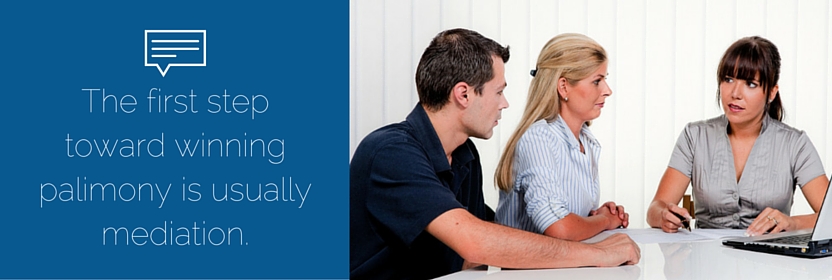When the popular actress Gwyneth Paltrow divorced in 2015, ABC News said it was the latest example of an out-of-control divorce rate that is “fifty percent and climbing.” A Fox News anchor recently blamed poverty in the United States on the divorce rate “going up.” And when Bravo introduced its divorce reality show Untying the Knot in 2015, the network called divorce “a situation that fifty percent of married couples unfortunately end up in.” More than half of all marriages end in divorce, and the divorce rate is on the rise. That’s the conventional wisdom and the general consensus, but is it the truth?
Not at all, according to recent statistics including a survey sent out by the Census Bureau to 3.5 million addresses in the U.S. every year. Divorce has declined about three percent since 2008, and the long-term trend is downward. The divorce rate for first-time marriages is currently 41 percent and dropping. Still, if you are considering or anticipating a divorce, you need to seek out a good divorce lawyer at the very beginning of the process, and in southern California, you should speak with an experienced Los Angeles divorce attorney.
Why The Decline?
Why is the divorce rate plunging now in the United States? Observers and pundits have offered a number of reasons, and probably all of those reasons play some part in the ongoing reduction of the U.S. divorce rate. Certainly one reason the official divorce rate is declining is because more couples are choosing to live in cohabitation arrangements, and when those arrangements dissolve, the breakups don’t count as divorces. In other words, fewer marriages mean fewer divorces overall and a declining divorce rate. “It’s becoming more acceptable to be in a long-term, committed relationship without a legal document,” says Pamela J. Smock, director and research professor at the Population Studies Center at the University of Michigan-Ann Arbor.
According to the Population Studies Center’s research, between 1995 and 2010, first-time cohabitation jumped by 43 percent for white women, 57 percent for Hispanic women, and 39 percent for African-American women. Marriage is seen as more “optional” for young adults in the 21st century, whereas in the 1960’s, almost ninety percent of the U.S, population married in their twenties. It was virtually universal marriage, and about half of those couples eventually divorced in the divorce “boom” of the 1970s and 1980s. Today, fewer people are marrying, they’re marrying later, and they seem to be taking their marriage commitments more seriously. With more women empowered, earning, and independent, the choice to marry is more and more becoming a truly free and fully voluntary choice. Despite some loudly-articulated fears about the decline of the traditional institution of marriage, marriages in the United States are in fact stronger today than they have been in a number of decades. The divorce rate peaked in the 1970s and early 1980s, and it’s been declining since that time.
About 70 percent of the marriages that began in the 1990s reached their fifteenth anniversary (excluding those in which a spouse passed away), up from about 65 percent of those that began in the 1970s and 1980s. Those who have married in the 2000s are so far divorcing at even lower rates. If current divorce rate trends continue, nearly two-thirds of today’s marriages will not end in divorce, according to data from University of Michigan economist Justin Wolfers.
A Number Of Factors
Birth control, which first became widely available in the 1960s, and abortion, which became legal in every state in the nation in 1973, are also among the reasons why divorce is declining. Birth control and legal abortion have virtually eliminated the coerced or “shotgun” marriages that were actually rather frequent prior to the 1960s. Cohabitation, birth control, abortion, and the rising age of those entering first marriages are all functioning to reduce the divorce rate in the United States. These same forces are helping to reduce the divorce rate in parts of Europe, too.
Education also seems to be playing a role in lower divorce rates. According to Justin Wolfers at the University of Michigan, the ongoing decline in divorce is most pronounced among couples with college educations. Of the college graduates who married in the early 2000s, only about eleven percent divorced before their seventh anniversary, but for people without college degrees, seventeen percent were divorced before the seventh anniversary, according to Mr. Wolfers’ research.
The New Marriage Model
Andrew Cherlin, a sociologist and the author of Labor’s Love Lost: The Rise and Fall of the Working-Class Family in America, takes another approach. He believes that a new “model” of marriage is being developed by college graduates in Europe and the United States, and that working-class couples without college degrees may be lagging behind. “Better-educated Americans have found a new marriage model in which both spouses work and they build a strong economic foundation for their marriage,” says Cherlin. Working-class families, on the other hand, may hold more traditional notions about male breadwinners, yet economic changes – such as outsourcing and the transformation from an “industrial” economy to an “information and service” economy – have left many of the men in these working-class families struggling to find sufficient, stable, long-term employment. As a result, working-class couples are now divorcing at higher rates than college-educated couples, and that’s a situation that may not change until the newer “model” of marriage is more widely accepted.
In the 1960s and earlier, the marriage “model” was a breadwinning male and a homemaking female who both needed the other’s contribution to the household. That changed in the 1970s. For the first time, women entered the work force by the millions, and they simultaneously gained reproductive rights. The long historical perspective may eventually show us that the skyrocketing divorce rates of the 1970s and 1980s represented an irregularity. The divorce spike occurred at the same time as a new feminist movement and the emergence of reproductive freedom. Today, society has generally adapted to those changes, and the divorce rate is once again where it should be – on the decline. Marriage has now evolved into a new, 21st-century model based on love, two incomes, and shared interests as well as shared household duties.
Those who are waiting longer to get married are a big part of the picture. Prior to marriage, people are taking more time to mature, to build financial stability, to understand what they want in a partner, and to find one. The median age for marriage in 1890 was 26 for men and 22 for women. By the 1950s, that age had plummeted to 23 for men and 20 for women. In 2004, the average marriage age had climbed back to 27 for men and 26 for women.
Growing Concerns
While no one disputes that a lower divorce rate is good news, there are a number of growing legal concerns regarding the millions of couples who now live in cohabitation arrangements. In fact, one group of family law attorneys in the United Kingdom is advocating formal, legal safeguards for cohabiting partners in that nation. To receive legal protection when a cohabitation relationship ends in the United States, you need to have some kind of a contract – written, oral, explicit, or implicit – that you can offer to a court if you need to receive “palimony” when your cohabitation arrangement ends. “Palimony” is not a legal term, but the concept is comparable to alimony in California and a number of other states. Palimony is the division and distribution of financial assets and real property upon the dissolution of a cohabitation relationship between parties who are not legally married. In some cases and in some states, it may not be possible to win a palimony settlement or payments, but many have succeeded with the help of an experienced divorce lawyer.
The first step toward winning palimony is usually mediation. If the ex-partners in a cohabitation arrangement can resolve their dispute with the help of a mediator – and avoid lawsuits and courtrooms – they can save time, resources, and probably a great deal of aggravation and grief. If mediation fails to resolve the dispute, depending on the state you reside in and the specifics of the case, an experienced divorce lawyer may be able to take a palimony claim to trial. In the 1976 Marvin v. Marvin case, the California Supreme Court ruled that non-marital relationship contracts may be legally enforced. Such contracts may be expressed, implied, oral, or written, but they must be provable in court. If you need palimony – or if you expect to be part of a palimony dispute – you must retain an attorney who routinely handles palimony and divorce cases.
To protect themselves, cohabiting partners should consider drawing up a contract similar to a prenuptial or postnuptial agreement. You can draft an agreement that spells out each partner’s protections, rights, and obligations in the event of a breakup. An experienced divorce lawyer can help most couples in most states create the agreement that’s right for their particular circumstances. If you have questions or concerns regarding divorce, cohabitation, or any matter of family law, or if you need legal representation in a divorce or a post-cohabitation dispute, speak at once with a good divorce lawyer, and in southern California, with an experienced Los Angeles divorce attorney.


 Call Us Now
Call Us Now Email Us Now
Email Us Now




